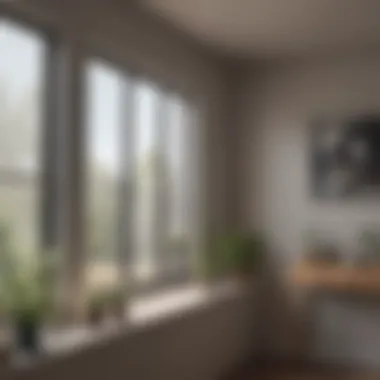Understanding Condensation on Windows: Causes and Solutions


Intro
Condensation on windows is a common issue faced by many homeowners. It manifests when moisture from the air settles on cooler surfaces, forming water droplets. Understanding why this occurs is essential for maintaining a comfortable and healthy home environment. This article delves deep into various causes of condensation, its impacts on living spaces, and practical solutions to mitigate the issue.
By recognizing the relationship between indoor humidity and temperature, homeowners can implement effective strategies to manage condensation. This not only enhances energy efficiency but also prevents potential damage caused by excess moisture accumulation. Below, we will explore key concepts relevant to window condensation, focusing on innovative design solutions and practical maintenance tips.
Preface to Window Condensation
Condensation on windows is a common phenomenon that can lead to various challenges in residential and commercial spaces. It occurs when moisture in the air comes into contact with colder surfaces, such as glass, and transforms from gas to liquid. Understanding this process is crucial for home maintenance and design. The implications of condensation are significant, affecting not only aesthetics but also health and energy efficiency.
Defining Condensation
Condensation refers to the conversion of water vapor into liquid water. This process is influenced by temperature and humidity levels within an environment. When warm, moist air meets a cool surface, it cools rapidly. The temperature drops below a specific point, known as the dew point, where moisture condenses into droplets. This process can manifest in various locations, but windows are particularly susceptible due to their exposure to external temperatures.
The Physics of Moisture
Moisture in the air plays a critical role in the condensation process. When air is warm, it can hold more moisture. However, as the temperature drops, the ability of air to retain water vapor decreases, often leading to condensation on cooler surfaces like windows. The physics involved is a delicate balance between temperature, humidity, and the dew point. Certain geographical and seasonal factors can further complicate this balance, making some regions more prone to condensation issues than others.
Types of Condensation
Understanding the different types of condensation can aid in addressing the issues related to it. They include:
Surface condensation
Surface condensation occurs when warm, moist air directly contacts a cooler surface. This is the most visible form, often seen as droplets on the interior of windows. Its simplicity in formation stems from the basic principles of thermodynamics. Surface condensation can be a significant concern as it often indicates poor insulation or high humidity levels that can lead to other issues, such as mold growth.
Interstitial condensation
Interstitial condensation takes place within building materials, allowing moisture to form between layers of materials, such as between window panes or within walls. This type is less visible and can often go unnoticed, leading to serious structural damage over time. Recognizing the risks associated with interstitial condensation is essential; it emphasizes the need for effective insulation during construction or renovations.
Fogging
Fogging is a phenomenon often seen in double-glazed windows, where the space between panes becomes humid and foggy. This occurs due to a failure in the seal that is meant to protect the inner airspace. While fogging might appear merely aesthetic, it can signal potential energy efficiency loss. This indicates that windows may no longer provide adequate insulation, driving up energy costs and impacting comfort within the home.
Understanding these types helps homeowners identify the root causes of condensation and implement appropriate solutions.
Causes of Condensation on Windows
Understanding the causes of condensation on windows is crucial for developing effective strategies to manage this common issue. Condensation occurs when moisture in the air meets cooler surfaces, leading to water droplets forming on windows. This can affect the household environment significantly, causing problems that go beyond simple aesthetics. Identifying the underlying causes can help homeowners and design enthusiasts prevent damage and maintain a healthy indoor space.
Indoor Humidity Levels
Indoor humidity levels play a vital role in the formation of condensation on windows. When humidity is high, the air becomes saturated with moisture. Activities such as cooking, showering, or even breathing add significant moisture to indoor air. Ideally, indoor humidity should be between 30% and 50%. Higher levels contribute to condensation, especially when outside temperatures drop. Monitoring humidity using hygrometers can help maintain levels conducive to comfort and prevent excessive condensation.


Temperature Differentials
Temperature differentials between indoor and outdoor environments greatly influence condensation. When warm indoor air contacts the cold surface of a window, it cools rapidly. This cooling causes the air to lose its capacity to hold moisture, resulting in condensation. During winter months, this effect is often pronounced due to the significant temperature gap. Homeowners should be aware of this dynamic, as maintaining a consistent indoor temperature can help reduce the risk of condensation on their windows.
Poor Insulation
Poor insulation is another critical factor contributing to window condensation. When windows are not properly insulated, cold air seeps through, causing the interior window surfaces to chill. This cold surface is more likely to collect moisture from humid indoor air. Upgrading to better insulation options or replacing old windows with energy-efficient models can help mitigate this issue. Double glazing, for instance, is effective in creating a thermal barrier and reducing condensation problems.
Ventilation Issues
Ventilation plays a key role in managing indoor air moisture levels. Lack of proper ventilation can lead to trapped humidity, escalating the likelihood of condensation. Enclosed spaces accumulate moisture from daily activities, making it essential to enhance airflow. Installing exhaust fans in kitchens and bathrooms can help alleviate moisture buildup. Additionally, utilizing dehumidifiers can further enhance indoor air quality. Proper ventilation is not only crucial for reducing condensation but also for maintaining a healthy living environment.
Proper management of these factors can significantly reduce the occurrence of condensation, leading to improved indoor conditions.
In summary, understanding these causes helps in implementing effective measures against condensation. Addressing indoor humidity levels, temperature differentials, insulation quality, and ventilation can lead to a noticeable decline in condensation-related issues. This knowledge is not only beneficial for homeowners looking to maintain their property but also for any design enthusiast aiming for an aesthetic and functional indoor space.
Impacts of Window Condensation
Window condensation is more than just a nuisance. It has significant impacts that can affect the overall condition of a home. Understanding these impacts is crucial for homeowners who seek to maintain both the integrity and comfort of their living spaces. This section will explore the various effects of window condensation, including health risks, property damage, energy loss, and aesthetic issues.
Mold Growth and Health Risks
Condensation provides an ideal environment for mold growth. Mold thrives in damp conditions, often leading to severe health risks. Respiratory issues, allergies, and skin irritations can all stem from prolonged exposure to mold spores found in damp areas. Specifically, homes with persistent condensation around windows can harbor toxic molds.
To mitigate these risks, homeowners should regularly inspect areas with high condensation rates. Immediate action should be taken if mold is identified, including cleaning the affected areas with appropriate solutions such as diluted vinegar or specialized mold removers. Effective ventilation and humidity control are also key strategies in preventing mold growth.
Damage to Window Frames and Surroundings
Moisture accumulation from condensation can significantly damage window frames and surrounding structures. Wooden frames may swell, warp, or even rot over time, contributing to costly repairs. In some cases, the integrity of the wall structure can be compromised. Along with the physical damage, this can lead to additional issues, such as pest infestations and decreased property value.
Homeowners are advised to consider materials less susceptible to moisture, such as vinyl or aluminum. Regular maintenance, such as repainting or sealing, can also help protect wooden frames. Keeping the surrounding area dry ensures that condensation does not lead to extensive damage.
Energy Efficiency Loss
Condensation directly influences the energy efficiency of a home. When moisture builds up in the air, it can lead to increased heating and cooling demands. A home that is not properly sealed or insulated allows for thermal escape through windows, resulting in higher energy bills. This means homeowners are not only spending more on utilities but may also face higher emissions associated with energy usage.
To enhance efficiency, homeowners should explore upgrading to energy-efficient windows, such as double glazed or low-emissivity glass options. The investment in quality window materials can yield significant energy savings over time. Maintaining proper insulation throughout the home is equally important in preventing energy loss.
Aesthetic Concerns
Beyond the structural and health implications, window condensation can have aesthetic impacts on the home. Water droplets on the glass create a perception of neglect, which can be unappealing to residents and guests alike. Over time, persistent condensation can lead to unsightly stains on window frames and walls.
To address these aesthetic issues, homeowners should prioritize proper design choices and decor that promote air circulation, such as using lighter curtains or blinds. Additionally, regular cleaning and maintenance help maintain visual appeal. Keeping the interior environment balanced and dry can reduce the frequency and severity of condensation, enhancing the overall appearance of the home.


Effective management of window condensation not only protects your home from damage but also significantly improves the quality of indoor life.
Practical Solutions to Manage Condensation
Addressing condensation on windows is not only necessary for maintaining aesthetic integrity but also for safeguarding structural and health aspects of a living space. This section focuses on engaging with practical solutions that can address condensation, taking into consideration various aspects like efficiency and feasibility.
Controlling Indoor Humidity
Controlling indoor humidity is critical in combatting condensation. High humidity levels not only lead to physical discomfort but also encourage mold growth and structural damage over time. The ideal indoor humidity level should be around 30-50%.
To manage these levels effectively, consider the following strategies:
- Use exhaust fans in high-moisture areas such as kitchens and bathrooms.
- Ensure that the house has adequate ventilation, drawing in dry air from outside.
- Monitor humidity levels consistently with a hygrometer to adapt your strategies accordingly.
By keeping humidity at optimal levels, the likelihood of condensation forming on windows reduces significantly.
Improving Air Circulation
Good air circulation prevents stagnant air which can be conducive to condensation. Establishing a flow of air can significantly aid in managing moisture levels in confined spaces. Here are two approaches that can be particularly effective:
Installing exhaust fans
Exhaust fans play an essential role in improving air circulation. They effectively remove humid air from spaces like bathrooms and kitchens, replacing it with dryer air from the rest of the house. One key characteristic of exhaust fans is their ability to operate quietly while efficiently drawing moisture-laden air outside. This is especially beneficial in climates where humidity is a persistent concern.
However, it is important to ensure that these fans are used appropriately. For instance, running the exhaust fan during and after activities like showering or cooking enhances efficiency. The disadvantage of exhaust fans is that they might inadvertently increase heating costs in winter if not managed properly, due to the loss of warm air.
Using dehumidifiers
Dehumidifiers provide another effective means to control indoor moisture levels. They actively pull moisture from the air, allowing for a significant reduction in humidity. A crucial feature of dehumidifiers is their portability and versatility. They can be placed in particular rooms based on need, making them personalized solutions. They are globally popular due to their proven effectiveness in preventing condensation.
On the flip side, they require regular maintenance, including emptying water tanks and cleaning filters, which can be seen as a disadvantage. Nonetheless, their utility in lowering humidity makes them a favorable choice for many homeowners.
Enhancing Insulation
Improving insulation is paramount in any effective condensation management strategy. A well-insulated home prevents warm air from escaping and offers resistance to cold from outside. Materials used in insulation can include spray foam, fiberglass, or rigid foam board.
Inadequate insulation around windows is a primary cause of temperature differentials that lead to condensation. By investing in quality insulation, homeowners can help ensure that warmer air remains indoors while reducing the chances of condensation forming on cold window surfaces.
Selecting Appropriate Window Materials
The choice of window materials has a direct impact on condensation levels. Selecting appropriate window materials can help significantly in managing moisture. Two popular options stand out in this regard:
Double glazing


Double glazing involves two panes of glass with a gas-filled space between them, enhancing thermal insulation. Its main characteristic is its ability to reduce heat transfer, minimizing temperature differences that lead to condensation. This makes it an excellent choice for homeowners aiming to improve energy efficiency while tackling condensation issues.
However, double glazing can come with a higher upfront cost which some might consider a disadvantage. Despite this, many view it as a long-term investment that pays back through lower energy bills and reduced maintenance needs.
Low-emissivity (Low-E) glass
Low-emissivity glass is specially treated to reflect heat back inside. This innovative material effectively maintains consistent indoor temperatures, preventing condensation. A notable advantage of Low-E glass is that it offers all the benefits of traditional double glazing while also blocking harmful UV rays.
Although it can be pricier than standard glass, the enhanced thermal performance generally offsets these costs over time. Homeowners looking to invest in durable and effective solutions will find Low-E glass a compelling option.
By focusing on these practical solutions, homeowners can actively manage and reduce the condensation that can lead to potential problems in the long run.
Long-term Strategies for Prevention
Long-term strategies for preventing condensation on windows are essential for maintaining a healthy indoor environment. These strategies not only address the current issues of condensation but also reduce future risks. Focusing on prevention can lead to lower energy costs, enhance the longevity of windows and frames, and foster a comfortable home atmosphere.
Regular Maintenance Checks
Regular maintenance checks are crucial in preventing condensation. Homeowners should periodically inspect their windows for any signs of wear or damage. Gaps or cracks in frames can allow humid air to escape indoors. Proper sealing helps minimize moisture entry. Furthermore, checking for proper functioning of ventilation systems is important.
- Inspect window seals: Any deterioration can lead to moisture infiltration.
- Check insulation: Ensure that insulation is intact and performing as expected.
- Monitor window frames: Look for signs of rot or mold, which indicate excessive moisture accumulation.
Renovations that Reduce Condensation Risk
Renovations can significantly reduce the risk of condensation. Upgrading windows and improving insulation are effective measures.
- Install energy-efficient windows: Windows with double glazing can reduce temperature differentials that cause condensation.
- Enhance attic insulation: A well-insulated attic prevents heat loss, reducing the risk of colder surfaces indoors.
- Integrate vapor barriers: Including vapor barriers in renovations can effectively manage moisture levels in the home.
Educating Occupants on Humidity Management
Educating occupants about humidity management is vital. Understanding how to control indoor humidity levels can make a significant difference in condensation occurrences.
- Use hygrometers: Provide tools to monitor humidity levels in the home.
- Implement daily routines: Encourage habits like opening windows or using exhaust fans during cooking and showering.
- Discuss moisture sources: Inform residents about various moisture-producing activities, such as drying laundry indoors.
Maintaining low humidity can help to avoid health risks related to mold and improve overall comfort. Regular conversations about these strategies can enhance awareness and lead to better practices in moisture management.
Ending
Understanding condensation on windows is essential for maintaining a healthy home environment. This article has explored the science behind condensation and its various causes, including indoor humidity levels and temperature differentials. By recognizing these factors, homeowners can take steps to mitigate issues related to condensation.
Summarizing Key Points
- Defining Condensation: Condensation occurs when warm, moist air comes into contact with a cooler surface, resulting in water droplets forming. It is crucial to understand the conditions that lead to this phenomenon to effectively address it.
- Causes of Condensation: Key causes include high indoor humidity, significant temperature contrasts between indoors and outdoors, inadequate insulation, and insufficient ventilation. Each of these can contribute to an increase in moisture, leading to more condensation.
- Impacts on Health and Property: Window condensation can create a breeding ground for mold, cause damage to window frames, reduce energy efficiency, and detract from a home's appearance. Recognizing these impacts helps motivate proactive measures.
- Practical Solutions: Managing humidity levels, enhancing air circulation, and selecting appropriate window materials are practical solutions to combat condensation. These strategies can reduce the chance of moisture accumulation significantly.
- Long-term Strategies: Regular maintenance checks, thoughtful renovations, and education about humidity management can lead to lasting solutions against condensation issues.
Encouraging Proactive Measures
Homeowners should take decisive action to prevent and manage window condensation. Simple practices like regulating indoor humidity with dehumidifiers or utilizing exhaust fans can make a notable difference. Additionally, investing in high-quality double glazing or Low-emissivity (Low-E) glass can serve as a long-term solution to minimize condensation risk.
By being informed, individuals can protect their homes from potential damages related to condensation. Encouraging discussions about moisture management and staying proactive in prevention strategies will lead to healthier living spaces. Understanding condensation not only fosters a better home environment but can also add value to the property.















